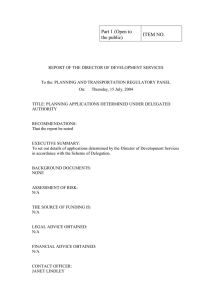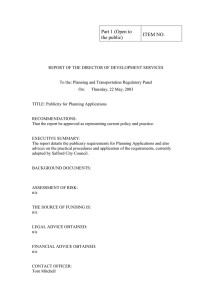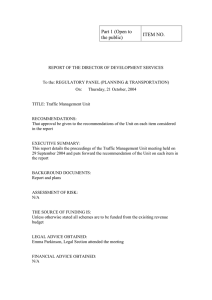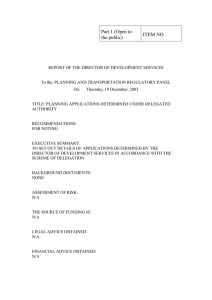Part 1 (Open to ITEM NO. the public)
advertisement
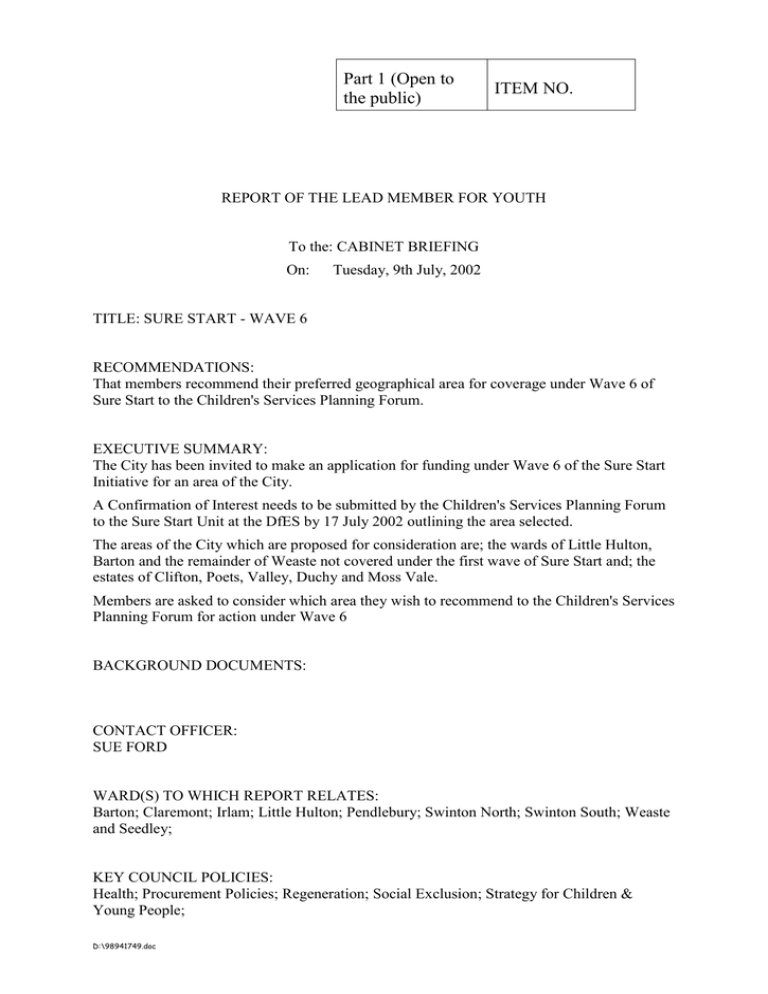
Part 1 (Open to the public) ITEM NO. REPORT OF THE LEAD MEMBER FOR YOUTH To the: CABINET BRIEFING On: Tuesday, 9th July, 2002 TITLE: SURE START - WAVE 6 RECOMMENDATIONS: That members recommend their preferred geographical area for coverage under Wave 6 of Sure Start to the Children's Services Planning Forum. EXECUTIVE SUMMARY: The City has been invited to make an application for funding under Wave 6 of the Sure Start Initiative for an area of the City. A Confirmation of Interest needs to be submitted by the Children's Services Planning Forum to the Sure Start Unit at the DfES by 17 July 2002 outlining the area selected. The areas of the City which are proposed for consideration are; the wards of Little Hulton, Barton and the remainder of Weaste not covered under the first wave of Sure Start and; the estates of Clifton, Poets, Valley, Duchy and Moss Vale. Members are asked to consider which area they wish to recommend to the Children's Services Planning Forum for action under Wave 6 BACKGROUND DOCUMENTS: CONTACT OFFICER: SUE FORD WARD(S) TO WHICH REPORT RELATES: Barton; Claremont; Irlam; Little Hulton; Pendlebury; Swinton North; Swinton South; Weaste and Seedley; KEY COUNCIL POLICIES: Health; Procurement Policies; Regeneration; Social Exclusion; Strategy for Children & Young People; D:\98941749.doc DETAILS: 1. INTRODUCTION 1.1 Sure Start is a programme funded by the DfES via the Sure Start Unit. It aims to work with parents-to-be, parents and young children from birth to the age of four to promote their physical, intellectual and social development – particularly those who are disadvantaged – so that they can flourish at home and when they get to school, and thereby break the cycle of disadvantage for the current generation of young children. 1.2 The City already has two programmes funded under Waves 1 and 3 of Sure Start, the first in Seedley Langworthy and the Precinct (which covers part of Weaste) and the second in Winton. There are two further areas for which the Sure Start Unit is currently considering Plans. These are Ordsall/Blackfriars and Broughton (see attached Plan). 1.3 The City has been invited to submit an application for a further area of the City under Wave 6 and indications are that up to £800,000 per annum revenue and an allocation of up to £1 million capital will be made available to each area. Funding in the first instance is for three years but may be available for up to 10 years. 1.4 Responsibility for managing the existing Sure Start programmes lies with the Sure Start Partnership. The existing programmes are lead by Salford PCT who also act as accountable body. 2. PURPOSE OF REPORT 2.1 Confirmation of interest in making applications must be submitted to the Sure Start Unit by 17 July 2002. Applications must outline the area to be targeted under Wave 6. Members are asked to consider which area they wish to recommend to the Children’s Services Planning Forum for targeting under Wave 6. 3. THE APPLICATION PROCESS 3.1 The application process, set out by the Sure Start Unit is as follows: Activity Confirmation of Interest Target Dates 17 July 2002 Sure Start Unit accepts Confirmation of Interest Sure Start Partnership submits Progress Report (including request for funding of early services up to £100,000) Sure Start Unit gives feedback and agrees grant for immediate services Full Plans submitted Plans Approved Mid August 2002 Detailed capital plans due D:\98941749.doc 16 October 2002 Early November 2002 22 January 2003 March 2003 onwards End of April 2003 3.2 Confirmations of Interest should include: Details & description of the catchment area; The name(s) of the organisation(s) acting as lead partner and accountable body A statement of commitment from key statutory and voluntary agencies that provide mainstream services from Chief Executives or Directors; The number of children under 4 in the catchment area; A list of initial partners involved in the decision-making process to date and details of who will be responsible for driving forward the development of the plan; An outline of resources to be made available to develop the plan. 4. POTENTIAL AREAS FOR CONSIDERATION 4.1 For early waves of Sure Start the guidance on selection of catchment area indicated that the area should Include between 400 and 800 (in some circumstances up to 900 may be considered) children aged under 4 years Be one of the most needy areas in the district with high levels of child poverty and disadvantage Serve a coherent neighbourhood whose boundaries make sense to local people Comprise communities that are amongst the 20% most deprived in England, and Have accessible services for parents 4.2 However the new Guidance for Waves 5 and 6 also stresses that: “Catchment areas selected for Sure Start should be the poorest in the district that meets the Sure Start criteria” “The area or areas that make up the catchment area should normally fall within the poorest 20%, and preferably the poorest 10%, in England. If the most obviously disadvantaged areas are not chosen, the partnership will have to provide clear reasons why and make a strong case for the area that is selected instead.” The Wave 6 guidance also offers a further option in selecting a programme area – The Cluster Programme. It states that if we are unable to identify a single poor area with enough under four’s then we can consider a single programme that consists of two non-adjacent areas. Each area must have no fewer than 200 children under 4 with a total number across both areas not exceeding 700 (single areas can have up to 900). D:\98941749.doc 4.3 15 of the City’s wards fall within the poorest 20% of wards nationally on the DETR Index of Multiple Deprivation 2000 and nine of these are within the poorest 10%. These are as follows: Ward National City Ranking Ranking Broughton 126 1 Little Hulton 138 2 Blackfriars 156 3 Wards within Ordsall 166 4 the 10% poorest Pendleton 201 5 nationally Langworthy 260 6 Winton 471 7 Weaste & Seedley 570 8 Barton 729 9 Wards within Walkden North 880 10 the 11-20% Pendlebury 1030 11 poorest Kersal 1542 12 nationally Eccles 1551 13 Swinton North 1608 14 Cadishead 1652 15 4.4 We already have 2 Sure Start areas underway as follows: Seedley, Langworthy and the Precinct; Winton And two areas agreed by the Sure Start Unit. The Unit is currently considering the Plans that have been developed for these areas: Ordsall and Blackfriars Broughton The areas covered by these programmes are shown on the Plan attached to this report. 4.5 Given the emphasis in selecting the most deprived areas of the City under Wave 6 we will again need to consider the wards in the DETR Index within the 10% most deprived which are not covered by an existing Sure Start. These are: Little Hulton Barton, Parts of Weaste not covered by an existing Sure Start programme Parts of Pendleton not covered by an existing Sure Start programme. However we also have 5 estates that have enumeration districts within the worst 10% of ED’s nationally under the DETR 1998 Index of Deprivation. These are: D:\98941749.doc Clifton Estate (Pendlebury) Poets Estate (Swinton North) Valley Estate (Swinton South) Duchy Estate (Claremont) Moss Vale Estate (Irlam) However, the New Deal for Communities programme, which covers the remainder of the Pendleton ward, has included an element for Sure Start type activity and it is not proposed to consider this area under wave 6. 4.6 The under 4 child population figures used in this report have been obtained from the Child Health records held by Salford PCT. These figures have been used, as they are the most accurate up to date figures we have available on a small area basis for the City. These identify the under 4 populations as: Little Hulton Barton Weaste Clifton Poets Valley Duchy Moss Vale 721 612 36 217 120 120 10 244 Clearly the population criteria mean we must discount Weaste, Poets, Valley and Duchy. The population figures for Clifton and Moss Vale are not sufficient for single area Sure Start programmes and would need to be considered under the Cluster Programme category. 5. DETAILS OF SELECTION OPTIONS 5.1 The selection options for Wave 6, based on the criteria in the guidance, are: Single area programme: Little Hulton Barton Cluster programme – a combination of two from: Clifton Moss Vale 5.2 One of the key statistics, which will help to determine the area we select, is the DETR 2000 Child Poverty Index. Other key information also needs to be considered and the DETR ranking for each of the relevant wards is contained in the attached Annex. The following is a summary of each of the selection options. 5.3 Single Area Programmes: 5.3.1 Little Hulton The Little Hulton ward falls within the worst 10% of wards nationally and is the 2nd most deprived ward in the City in the DETR 2000 Multiple Deprivation Index. The area was covered by an SRB Initiative, which came to an end in March of this year. The Child Poverty Index shows that Little Hulton is within the worst 10% of wards nationally (ranking 6th in the City) and 45% of children claim free school meals. D:\98941749.doc The areas Education Ranking in the DETR Index puts the area in the worst 10% nationally although unauthorised absence is at the City average of 0.6%. The School Census 2002 show a low ethnic population of 0.8%. The area has the poorest health ranking in the City and is the 60 th worst ward nationally in the DETR index. It also has a high number of teenage conceptions (under 16 years) at 15.85 per 1000, which is the third worst in the City behind Walkden North and Langworthy. 55 children were Looked After by the Authority at the end of September 2001, this equates to approximately 17.7 children per 1000 and is the second highest ward proportion of Looked After Children in the City behind Langworthy. A further 14 children were on the Child Protection Register. The areas families and young people have benefited in the past five years from a number of initiatives including: The Youth and Families Project – funded through SRB Home Start – a voluntary run befriending service for families funded through Joint Financing Little Hulton Women and Family Centre – a voluntary sector project The Health Visiting service based at Little Hulton Health Centre is trialing different ways of delivering its service The Youth and Families Project is looking at ways of sustaining some of its activity through the Children’s Fund and is hoping to establish a Children’s Resource Centre. There is also an Early Years Centre on Longshaw Drive. The projects that have been established have engaged with the community in the area and there is a good base for consultation and involvement of families on which a Sure Start Initiative could build. 5.3.2 Barton Barton is within the worst 10% wards nationally on the DETR Index of Multiple deprivation and is the 9th most Deprived ward within the City. It is adjacent to the Wave 3 Sure Start area of Winton, which is now underway. However, the DETR Child Poverty and Education Indices 2000 indicate that the area is only within the worst 20% of wards nationally. This is reflected in the lower number of Free school meals at 27.7% and average rates of unauthorised absence from primary schools at 0.7%. The Barton area has the second highest ethnic population in schools in the City – 9.3% (105 children) – principally from the Yemini and Bangladeshi communities. There were 35 children in Barton who were Looked After on 30 September 2001. This equates to 17.1 children per 1000 and is the third highest proportion in the City behind Langworthy and Little Hulton. The predominant reason for being looked after is neglect. There were, however, no children on the Child Protection Register at the end of September 2001. The DETR Health index also ranks the ward in the worst 10%. Teenage conceptions (under 16) are higher than the City average at 12.3 per 1000. D:\98941749.doc 5.4 Cluster Programme The cluster programme could comprise a combination of two of either: 5.4.1 Clifton The Clifton estate is within Pendlebury ward, which is within the poorest 20% of wards nationally. However in the DETR 1998 Deprivation Index information was available down to ED level and this showed that the Clifton estate had one ED within the worst 10% nationally. This ED level data has not been reproduced for the 2000 Index as much of the data used to compile it was based on 1991 Census data and was felt to be out of date. All the DETR rankings for Pendlebury show the area to be within the worst 20% nationally 11.6 children per 1000 in Pendlebury are Looked After. However, more than 50% (18) of these children live in the Clifton area. A further 3 children are on the Child Protection Register in Clifton. There is a small ethnic population in Pendlebury ward, 2.4% of school children are from ethnic minority communities (School Census 2002). Other key statistics for the area are low. However, there is strong community involvement within the area particularly through the Clifton Initiative Group. There are several community buildings in the area and a Health Centre on Manchester Road, which could be considered for delivery of Sure Start services. The area has no early years facility although there is a Family Centre run by Spurgeons, which although not based in the area, does work with local families. 5.4.2 Moss Vale The Moss Vale estate is in the Irlam ward, which is within the worst 20-30% most deprived wards nationally. However part of the estate has enumeration districts within the 10% most deprived ED’s in the 1998 Index of Deprivation. The Child Poverty, Income and Health rankings for the 2000 Index all show the ward within the 11-20% most deprived wards nationally. However the Education an Employment ranking for 2000 show the area to be within the worst 30-40% and 20-30% respectively. A lower proportion of children in Irlam are Looked After than many other areas of the City - 7.7 children per 1000. However a high proportion of these children (13 out of 19) are from the Moss Vale area. A further 12 Children in the Irlam ward are on the Child Protection Register and all of them are from the Moss Vale area. Teenage conceptions are high for the Irlam ward at 12.1% and there is also a high proportion of low birth weight babies in the ward. The ethnic population is also below the City average, 1.7% of school children are from ethnic minority communities. D:\98941749.doc 6.0 AREA SELECTION All 5 areas clearly meet the criteria for Sure Start to varying degrees. The most deprived of the areas is Little Hulton, which is high on the deprivation indices and has a high proportion of Looked After Children and children on the Child Protection Register. Deprivation indices for Barton are high but are lower than for the Little Hulton area. Barton does have a similar level of Looked After Children to Little Hulton but no children on the Child Protection Register. It does, however, have a higher proportion of children from ethnic minority communities. The two areas for consideration in the cluster model have much lower deprivation rankings. The Cluster model in itself is problematical in its implementation in Salford. The two areas eligible for consideration under this model are physically far apart and fall within different Salford Primary Care Trust delivery areas and Community Committee areas. This would cause problems in the management of such a programme. Health Visitors are at the forefront of delivery of many Sure Start services and are the universal first contact with Sure Start. These members of staff are attached to GP’s and this would require the management of at least two sets of staff groups. It is recommended that the Cluster model be not adopted for Salford under Wave 6. It is therefore recommended that the Little Hulton area be agreed as the City Council’s preferred option for Sure Start Wave 6, on the basis that it is the most deprived area of the City not yet covered by a Sure Start programme. The City Council’s recommendation will be referred to the Children’s Services Planning Forum meeting on 12th July. D:\98941749.doc Ward Statistics for Areas for Consideration Under Sure Start Wave 6 Key Statistics 729 (9) 1030 (11) 1914 (16) Weaste and Seedley ward 570 (8) 276 (6) 1043 (10) 1271 (11) 1556 (12) 656 (8) 216 (3) 786 (9) 925 (11) 1529 (15) 573 (8) 222 (2) 760 (9) 1204 (11) 2093 (17) 575 (7) 45.5 27.7 19.9 20.5 45.5 60 (1) 305 (10) 427 (11) 1082 (16) 112 (4) 15.9 12.3 8.5 12.1 9.8 6.9 8.9 8.6 9.2 8.8 17.7 17.1 11.6 7.7 9.8 55 35 32 (18 in Clifton) 19 (13 in Moss Vale) 14 0 6 (3 in Clifton) 12 (12 in Moss Vale) 331 (4) 959 (8) 1880 (9) 3006 (13) 20 (12 in remaining part of ward for wave 6) 12 (11 in remaining part of ward for Wave 6) 2000 (10) Unauthorised Absence 0.6 0.7 0.4 % (City average = 0.6%) % School population 0.8 9.3 2.4 from ethnic minorities Note : For DETR 2000 Index City ward rankings are in brackets. 0.8 1.9 1.7 3.0 DETR Multiple Deprivation National Ranking DETR Child Poverty National Ranking DETR Income National Ranking DETR Employment National Ranking Free School Meals % in Primary Schools DETR Health National Ranking Teenage Conceptions Under 16 per 1000 Low Birth Weights % (average for City 8.9%) Looked After Children (for Social Services Areas) per 1000 No. Looked After Children 30 Sept 2001 No. on Child Protection Register 30 Sept 2001 DETR Education National Ranking D:\98941749.doc Little Hulton Ward 138 (2) Barton Ward Pendlebury Ward Annex 1 Irlam Ward D:\98941749.doc
